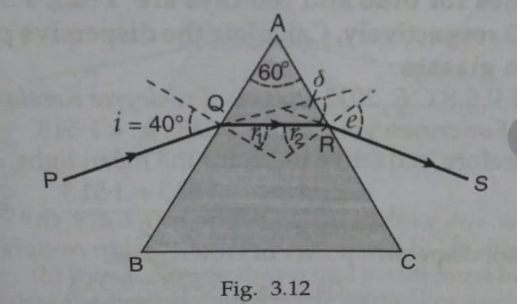An equilateral glass prism(μ=1.6) is immersed in water (μ=1.33). Calculate the angle of deviation produced for a ray of light incident at 40∘ on one face of the prism.
 .Solution in Punjabi
.Solution in Punjabi
Step by step video & image solution for An equilateral glass prism(mu=1.6) is immersed in water (mu=1.33). Calculate the angle of deviation produced for a ray of light incident at 40^@ on one face of the prism.. by Physics experts to help you in doubts & scoring excellent marks in Class 12 exams.
Updated on:21/07/2023Topper's Solved these Questions
- DISPERSIONBOOK - MODERN PUBLICATIONCHAPTER - DISPERSIONEXERCISE - EXERCISE
54 Videos
- Diffraction of LightBOOK - MODERN PUBLICATIONCHAPTER - Diffraction of LightEXERCISE - EXERCISE
65 Videos
- ELECTRIC CURRENT. RESISTANCE AND E.M.FBOOK - MODERN PUBLICATIONCHAPTER - ELECTRIC CURRENT. RESISTANCE AND E.M.FEXERCISE - EXERCISE
64 Videos
Similar Questions
For a prism prove that
A+δ=i+e
View SolutionWhat is diffraction of light?
View SolutionWhat is drift velocity of electrons? How do you explain the flow of current in a conductor based on this?
View SolutionA ray of light incident on an equilateral triangular glass prism of mu = sqrt(3) moves parallel to the base of the prism inside it. What is the angle of incidence for this ray ?
View SolutionA prism is made of glass of unknown refractive index. A parallel beam of light is incident on a face of the prism. By rotating the prism, the minimum angle of deviation is measured to be 40^@ . What is the refractive index of the prism ? If the prism is placed in water (mu = 1.33) , predict the new angle of minimum deviation of the parallel beam. The refracting angle of prism is 60^@ .
View SolutionA glass prism of angle 72∘ and refractive index 1.66 is immersed in a liquid of μ=1.33. Calculate the angle of minimum deviation.
View SolutionLight rays from a source are incident on a glass prism of index of refraction μ and angle of prism α At near normal incidence, the angle of deviation of the emerging rays is
View SolutionAn equilateral triangular prism is made of glass (mu = 1.5) . A ray of light is incident normally on one of the faces. The angle between the incident and emergent ray is
View SolutionA thin glass prism of μ=1.5 is immersed in water of μ=1.33 . The ratio of deviation of the ray in water to that in air for the same prism is
View SolutionA ray of light is incident on one face of a prism (μ=1.5) at an angle of 60∘. The refracting angle of the prism is also 60∘. Find the angle of emergence and the angle of deviation. Is there any other angle of incidence, which will produce the same deviation?
View SolutionAn equilateral glass prism of refractive index 1.5 is immersed in water. Find the angle of deviation produced when a ray of light is incident at 42^(@) on one face of the prism. (Refractive index of water = 1.33)
View SolutionA ray of light incident on an equilateral triangular glass prism of μ=√3 moves parallel to the base of the prism inside it. What is the angle of incidence for this ray ?
View SolutionA parallel beam of light is incident on a face of a prism of refracting angle 60∘. Find the refractive index of the prism if the angle of minimum deviation is 40. What is the new angle of minimum deviation if the prism is immersed in water of refractive index 1.33?
View SolutionA ray of light passes through an equilateral prism withμ=1.5. The angle of deviation is
View SolutionA light ray is normally incident on one face of equilateral glass prism of refractive index sqrt2 . The deviation of light ray is
View SolutionA prism is made of glass of unknown refractive index. A parallel beam of light is incident on a face of the prism. By rotating the prism, the minimum angle of deviation is measured to be 40^@ . What is the refractive index of the prism ? If the prism is placed in water (mu = 1.33) , predict the new angle of minimum deviation of the parallel beam. The refracting angle of prism is 60^@ .
View Solution
